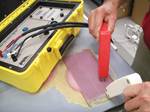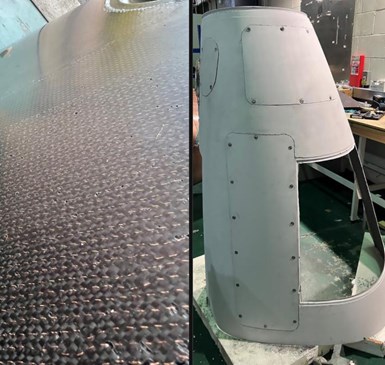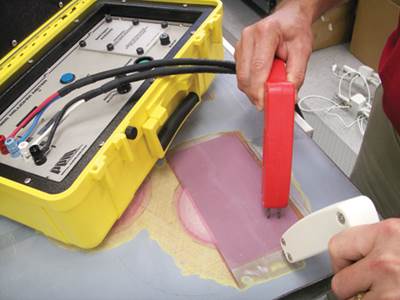D-JOINTS project helps engineers protect composite aircraft structures from lightning strikes
Design of innovative composite hybrid joints with electromagnetic compatibility project tested and validated two types of joint technologies plus software tool for faster design.
Clean Sky 2’s D-JOINTS (Design of innovative composite hybrid joints with electromagnetic compatibility) project has successfully tested and validated two types of joint technologies developed under the C-JOINTS project to protect aircraft from lightning strikes. The joints ensure that an aircraft’s external panels or structures, when made from composite material, are connected in a way that ensures that if hit by lightning, the electrical charge can be conducted safely between panels along the length of the aircraft, preventing damage or safety concerns.
This was not an issue in the days when aircraft were made of entirely metal construction — the electric charge of a lightning strike could be channeled towards the trailing edges of the aircraft and safely discharged. However, with the increased use of composite materials, managing a lightning strike becomes more complex.
The two technologies successfully developed in the C-JOINTS project included:
Tufting in demonstrator panel. Photo Credit: Clean Sky 2 D-Joints project, TWI, Cranfield University
- Tufting — an industrial stitching process, applied using robotics, whereby a thin copper thread is sewn through a composite panel to facilitate electrical conductivity.
- Thermal spraying — a process developed at TWI Ltd. (Cambridge, U.K.) whereby metal particles are sprayed onto composites to provide metallic connections that can carry energy between composite-composite panels and between composite-to-metal panels.
The purpose of the D-JOINTS project was to put these technologies to the test, validate their effectiveness and then incorporate the results into a “sizing tool.” This software tool helps engineers design specialized joints that can be embedded in aircraft panels and structures to protect aircraft from lightning strikes.
“This is a user-friendly software tool for engineers,” explains Sonia de la Cierva, project officer at Clean Aviation, “which helps them quickly specify the technical parameters, material characteristics and size of joints that are required when designing aircraft external panels and structures that require embedded protection from lightning strikes. The tufting and thermal spraying technologies were tested and validated for electromagnetic compatibility at demonstrator level on the nose section of the Evektor EV-55 aircraft.”
Moreover, the sizing tool is reported to save time in the design process by making specialized lightning strike protection (LSP) data easily accessible via a convenient user interface. Also, using the tool means that the exact amount of LSP material can be safely used in aircraft structures, thereby saving weight, cutting fuel-burn and curbing emissions.
D-Joint project team with demonstrators. Photo Credit: Clean Sky 2 D-JOINTS project, TWI, Cranfield University
A composite nose section demonstrator was tested in a relevant environment where it was subjected to simulated lightning strike conditions. Results indicated that these new technologies provided effective protection to aerostructures in the event of a strike, as well as protection from the indirect effects of lightning including the electromagnetic fields that lightning generates. These results were confirmed through successful assessment using a technique known as High-Intensity Radiated Field ground tests. Learnings from the project were integrated into the sizing tool.
Environmental advantages
Though the project’s main focus was on protecting composite structures from lightning strikes, the results also have clear environmental benefits. The sizing tool will assist designers in determining the appropriate size and shape of joints needed when designing integrated composite structures with LSP, which will save weight. This, in turn, reduces fuel consumption and emissions. The sizing tool also accelerates the time-to-market due to elimination of time-consuming design review iterations required to develop and produce joints. It does this by enabling the designer to quickly specify the most appropriate type of material combination that can be used for a particular joint.
“A further deliverable, encapsulating the compiled test outcomes and assessment of the environmental benefits is currently in progress,” says de la Cierva. “This will take the form of a summary document that classifies the benefits of the investigated technologies with evaluations of their cost and weight reduction.”
D-JOINTS ran from May 2020 until December 2022 with an EU budget of €468, 000. The project was coordinated by TWI Ltd. and supported by Cranfield University (Cranfield, U.K.) and Brunel University’s Composites Centre (Uxbridge, U.K.). The topic manager was aircraft manufacturer and engineering and manufacturing subcontractor Evektor (Kunovice, Czech Republic).
Related Content
Jeep all-composite roof receivers achieve steel performance at low mass
Ultrashort carbon fiber/PPA replaces steel on rooftop brackets to hold Jeep soft tops, hardtops.
Read More3D-printed CFRP tools for serial production of composite landing flaps
GKN Aerospace Munich and CEAD develop printed tooling with short and continuous fiber that reduces cost and increases sustainability for composites production.
Read MoreJEC World 2022, Part 3: Emphasizing emerging markets, thermoplastics and carbon fiber
CW editor-in-chief Jeff Sloan identifies companies exhibiting at JEC World 2022 that are advancing both materials and technologies for the growing AAM, hydrogen, automotive and sustainability markets.
Read MoreASCEND program update: Designing next-gen, high-rate auto and aerospace composites
GKN Aerospace, McLaren Automotive and U.K.-based partners share goals and progress aiming at high-rate, Industry 4.0-enabled, sustainable materials and processes.
Read MoreRead Next
After lightning strikes: Repair considerations
When lightning does strike, aircraft LSP system repairs must be done correctly to ensure restoration of protection.
Read MoreComposites manufacturing for general aviation aircraft
General aviation, certified and experimental, has increasingly embraced composites over the decades, a path further driven by leveraged innovation in materials and processes and the evolving AAM market.
Read MoreFrom the CW Archives: The tale of the thermoplastic cryotank
In 2006, guest columnist Bob Hartunian related the story of his efforts two decades prior, while at McDonnell Douglas, to develop a thermoplastic composite crytank for hydrogen storage. He learned a lot of lessons.
Read More





























